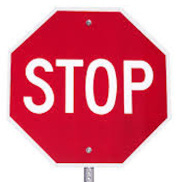On the Road Again – When and Where Do You Stop

On the Road Again – When and Where Do You Stop?
Many years ago, I was rearended during rush hour traffic. A twentyish man was not paying attention to the traffic. He rearended the car behind me, who rearended me. I, by design, had left enough room between me and the car in front of me so I did not hit them.
On freeways and surface streets, I see drivers who tailgate the cars in front of them when the traffic is moving. When traffic comes to a stop, these drivers are still close to the car in front of them.
I vaguely remember from driver training class that when you are driving in traffic, you want one car-length between you and the vehicle in front of you, for every ten miles per hour of your speed. For example, if you are driving at 30 miles per hour, you want the distance of three cars between you and the vehicle in front of you.
I do not remember if there was a similar rule of thumb for a safe distance between cars when stopped. When stopped at a red light or a stop sign, it is best to allow one-half to a full car length between you and the car in front of you. I would suggest a bit more room at the end of a freeway offramp.
The key factor is STOP! You are not special or entitled. Stop!
Once you are stopped, when should you start up again? If you are at a stop sign, go when there are no obstructions, people, or pets in your way and no traffic in your way or closely approaching. That seems obvious to me.
Then I started thinking about traffic signals. Many traffic signals are controlled by electronics that are connected to sensors embedded in the street. The photograph shown in this article shows the surface of a street with outlines of the sensors and the wiring. When a vehicle, a motorcycle or larger, passes over or stops over one of the sensors, an electronic signal is sent to the control box. The more vehicles that are detected by the sensors, the more signals are sent to the control box. In addition, the control box has timing mechanisms to make sure one direction does not get backed up too far.
A week or two ago, I was the first vehicle in line at a red light. I was in the right-hand lane. There was a car in the left-hand lane as well. I looked over to the left and noticed that the driver had not pulled up far enough to trigger the sensor closest to the intersection. Did that make any difference to how long we waited? I don’t know.
Another thought on traffic light sensors has to do with the issue I mentioned above: how close do you want to get to the vehicle that is stopped in front of you? The way the sensors are spaced out, the cars would need to be bumper to bumper to make sure they are all detecting the maximum number of cars at each red light. That seems too close for me.
A man I used to work with, told me about a drive he needed to make five days a week for a previous job. The drive required a left-hand turn at a traffic light controlled by sensors. His drive was around midnight and there was not much traffic at that time, so he would wait and wait for the left turn signal. Finaly, he figured out that if he pulled up to the intersection, waited a few seconds, and backed up a car length or so, and then pulled forward, the traffic light would change. He did that night after night, eventually without looking because no one was ever behind him. Until there was. If you are careful and aware of other traffic, this can shorten your waiting.
An additional source of locating places to visit is Can’t Travel? Go Virtual! for ways to find places to visit.
Happy travels!



